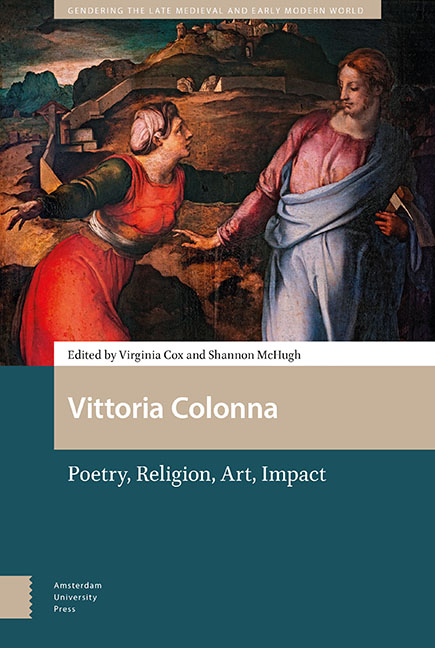Book contents
- Frontmatter
- Dedication
- Contents
- List of Illustrations
- Acknowledgements
- Introduction: The Twenty-First Century Vittoria Colonna
- Part 1 Literary and Spiritual Sociability
- Part 2 Widowhood
- Part 3 Poetry
- Part 4 Art
- Part 5 Readership
- Part 6 Impact
- Volume Bibliography
- Index of Citations of Colonna’s Letters and Verse
- Thematic Index
8 - ‘Inscribed Upon Their Hearts’: Copying and the Dissemination of Devotion
Published online by Cambridge University Press: 16 December 2021
- Frontmatter
- Dedication
- Contents
- List of Illustrations
- Acknowledgements
- Introduction: The Twenty-First Century Vittoria Colonna
- Part 1 Literary and Spiritual Sociability
- Part 2 Widowhood
- Part 3 Poetry
- Part 4 Art
- Part 5 Readership
- Part 6 Impact
- Volume Bibliography
- Index of Citations of Colonna’s Letters and Verse
- Thematic Index
Summary
Abstract
The close friendship shared by Vittoria Colonna and Michelangelo inspired the production of intimate gifts in the form of sonnets and presentation drawings. These works exercised a considerable fascination over their contemporaries, who sought to obtain copies of the poems and drawings in a variety of different media. Both individually crafted and mass produced, these copies possessed multiple valences for different audiences, revealing the ways in which the relationship between original and copy, function and medium, collecting and devotion intersected in the Cinquecento. This chapter explores the ways in which sonnets and drawings were appropriated by broader audiences, focusing especially on the translation of Michelangelo's Pietà drawing into bronze paxes created for popular, liturgical use.
Keywords: gift exchange, Michelangelo, paxes, Pietà
Vittoria Colonna and Michelangelo Buonarroti shared a friendship that was at once incredibly intimate and remarkably public. Through discussion, letters and the exchange of gifts, they explored in new ways the relationship between personal devotion and artistic expression. Their unique bond—as well as the poems, drawings and epistles that it produced—exercised considerable fascination over their compatriots, particularly those who were part of the same circles of Italian evangelicals known as spirituali. For contemporary scholarship this fascination persists, and analysis of these works has only further clarified the beliefs and mechanisms that characterised the networks of these reformers in the 1530s and 1540s. Colonna and Michelangelo used the same language to discuss the freely bestowed grace of God as they did their exchange of gifts, while the works themselves further explored critical themes of doubt, longing and the concept of sola fide through artistic and literary innovation. Despite, however, the inextricable links between form, content and contemplation that undergirded Colonna's Petrarchan rime spirituali—a genre that she invented—and Michelangelo's presentation drawings for Colonna—a genre that acquired an entirely new devotional significance in his hands—copies made after these works served a wide range of different audiences, often resulting in a refashioning of the relationship between devotion and aesthetics that they had originally embodied.
The fact that Colonna's poems and Michelangelo's drawings were so widely appropriated, copied, modified and marketed can be identified, in part, as a phenomenon of this particular historical moment. Individually both Colonna and Michelangelo were recognised as sui generis, the very models for distinctive authorship in the spheres of Cinquecento literature and the visual arts.
- Type
- Chapter
- Information
- Vittoria ColonnaPoetry, Religion, Art, Impact, pp. 173 - 198Publisher: Amsterdam University PressPrint publication year: 2021

